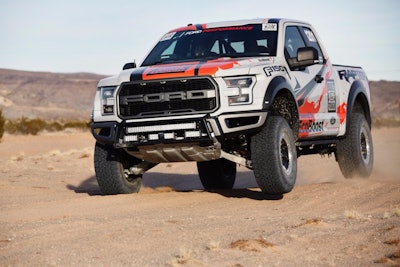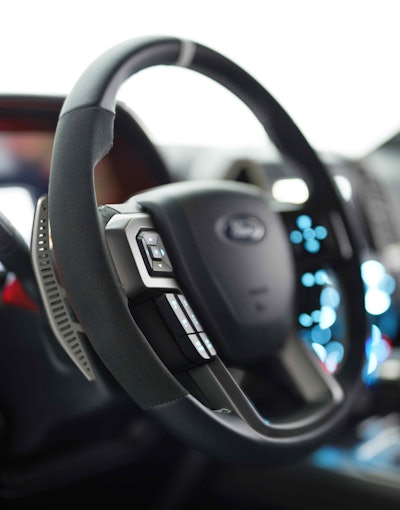 While you can’t see it, there’s a little bit of GM running in the 2017 Ford F-150 Raptor thanks to the new 10-speed transmission that both OEMs partnered up to produce.
While you can’t see it, there’s a little bit of GM running in the 2017 Ford F-150 Raptor thanks to the new 10-speed transmission that both OEMs partnered up to produce.While Ford hasn’t released final performance data on its new 2017 F-150 raptor, the truck’s smaller engine is revving up attention.
“It will blow away the old V8 in terms of power, torque and usable torque in lower rpms,” Jamal Hameedi, Ford performance chief engineer, tells The Fast Lane Truck in an interview posted on " target="_blank">YouTube. “It’s really just a vastly superior engine than the outgoing V8.”
Raptor’s larger and former 6.2-liter power plant generated 411 horsepower and 434 pound feet of torque. That’s respectable for sure, but Ford wanted more power and less weight.
Thanks to its lighter 3.5-liter high output EcoBoost engine combined with the truck’s new high-strength frame and all-aluminum body, Ford has cranked up the power and shed 500 pounds.
Ford’s new high performance 3.5-liter is a Frankenstein beast of sorts that traces its lineage to the current 3.5-liter EcoBoost on the F-150 and the Ford GT, according to Ford Truck Communications Manager Mike Levine.
“The current F-150 3.5-liter EcoBoost engine has 365 horsepower and 320 pound feet of torque,” Levine explains. “Now, when you look at the new engine, not only will we be making more power than that other 3.5, but we’ll be making more power than the 6.2-liter V8.
“Part of this is because if you look at the standard 3.5-liter EcoBoost—not the high output version—that one is direct injection. That’s part of EcoBoost, to have turbo-charged gasoline direct injection. The all new engine, which shares much of its architecture with the Ford GT, has both port injection and direct injection.”
So the result is a lot more power that will blow away, as Hameedi says, the 6.2-liter V8.
But power’s nothing without the right transmission, so Ford paired up its new 3.5 liter with a new 10-speed transmission that it developed with a longtime foe.
“It’s part of a partnership that we have with General Motors, but we manufacture the transmission for F-150 and we also have a unique calibration for F-150,” Levine says. “The transmission will be shared between Ford and General Motors.”
The transmission features a new terrain management system that let’s the driver select up to six different modes of terrain. Options are always important, so Ford included a manual mode of shifting for all ten gears right on the steering wheel.
 Ford’s 2017 F-150 Raptor features paddle wheel shifting. It’s a first in the high performance truck. The silver shifting lever is on the left side of the steering wheel.
Ford’s 2017 F-150 Raptor features paddle wheel shifting. It’s a first in the high performance truck. The silver shifting lever is on the left side of the steering wheel.Hameedi says he believes that it’s the first-time ever that a truck has featured paddle wheel shifting. So long as you don’t count the Ford Explorer as a truck, he may be right.
“It’s new for Raptors,” Levine says. “We didn’t have paddle shifters before. Customers weren’t saying, ‘I need paddle shifters.’ What customers were saying is I want as much control over my truck as possible. And one of the ways that we can give them that is allowing them to manually shift with the paddles, or they can drive the truck in automatic mode.”
Hameedi is impressed with how the 2017 Raptor handles versus last year’s model. The truck, he says, no longer plows through the sand thanks in part to its lighter weight.
“You can really tell a difference,” says Hameedi. “This one acts more like a sand rail in that it glides on top of the sand. It’s really noticeable.”
That should come in handy as the new Raptor takes on the 2016 Best in the Desert off-road racing series. The first race starts tomorrow in Parker, Az. Ford is the only OEM that will be competing. The Raptor will be competing in an all new stock class, though it will be modified slightly for safety and suspension performance.
“On the race truck, just like production, we have 3-inch diameter shocks. But instead of being internal bypass, like the production trucks, they’re external bypass,” Levine says. “The reason why we do this with the race trucks is so that the shocks can be tuned specific to race conditions.”
Raptor is in the 1200 class and is scheduled to compete against eight other trucks, including another Ford, a Toyota and a VW.









